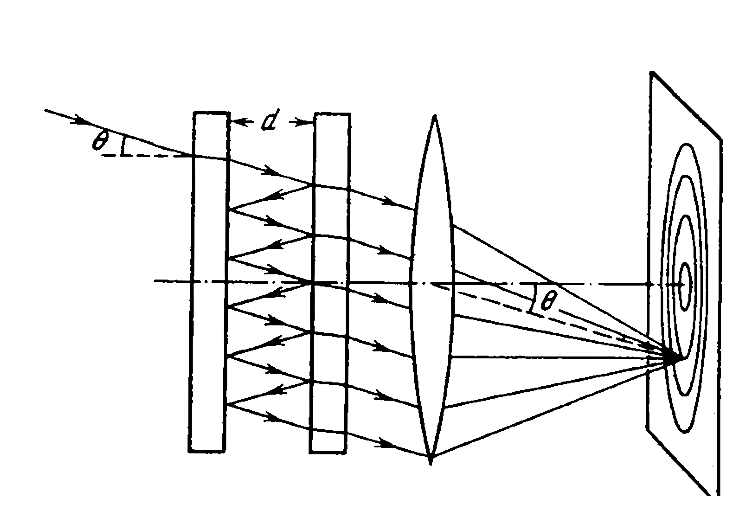Interference Of Light from IE IRODOV PHYSICS Chapter 9 OPTICS for Class 12
| Class 12 | PHYSICS |
| Chapter | OPTICS |
| IE IRODOV PHYSICS | Interference Of Light |
| Medium | English |
| Academic Year | 2023-2024 |
Question 1
Demonstrate that when two harmonic oscillations are added, the time-averged energy of the resultant oscillation is equal to the sun of the energies of the consituent osciallations, if both of them
(a) have the same direction and are incoherent, and all the values of the phase difference between the oscillations are equal probable,
(b) are mutually perpendicular, ahve teh same frequency and an arbitary phase difference.View SolutionQuestion 3
A certain oscillation results from the addition of coherent oscillations of the same direction results from the addition of coherent where k is the number of the oscillation (k=1,2,……….,N),φ is the phase difference between the kth and ~(k−1)th oscillations. Find the amplitude of the resultant oscillation.View SolutionQuestion 4
A system illustrated in Fig. consists of two coherent point sources 1 and 2 located in a certain plane so that their dipole moments are oriented at right angles to that plane. The sources are separated by a disatnce d, the radiation wavelength is equal to λ. Taking into account that the oscillations of source I by φ(φ<π), find:
(a) the angles θ at which the radiation intensity is maximum,
(b) the conditions under which the radiation intensity in the direction θ=π is maximum and in the opposite direction, minimum.
 View Solution
View SolutionQuestion 5
A stationary radiating system consists of a linear chain of parallel oscillators separated by a distance d, with the oscillation phase varting linearly along the chain. Find the time oscillators at which the principle radiation maximum of the system will be ''scanning'' the surroundings with the constant angular velocity ω.View SolutionQuestion 6
In Lloyd's mirror experiment (Fig.) a light wave emitted directly be the source S (narrow slit) interferes with the wave reflected form a mirror M. As s result, an interference fringe pattern is

formed on the screen Sc. the source and the mirror are separated by a distance l=100cm.At a certain position of the source the fringe width on the screen was equal to Δx=0.25mm, and after source was moved away from the mirror plane by Δh=0.60mm, the fringe width decreased η=1.5 times. Find the wavelength of light.View SolutionQuestion 8
Figure. Illustrates the interference axperiment with Fresnel mirrors. The angle between the mirrors is α=12' the distance from the mirrors intersection line to the narrow slit S and the screen Sc are equal to r=10.0cm and b=130cm resoectively. the wavelength of light is λ=0.55μm. Find:
(a) the width of a fringe on the screen and the number of possible maxima,
(b) the shift of the interference pattern on the screen when the slit is displaced by ∂l=1.0mm along the are of radius r with centre at the point O,
(c) at what maximum width ∂max of the slit the interference fringes on the screen are still observed sufficiently sharp.
 View Solution
View SolutionQuestion 10
A lens of diameter 5.0cm and focal length f=25.0cm was cut along the diameter into two identical halves. In the process, the layer of the lens α=1.00mm in thieckness was lost. Then the halves were put together to form a composite lens. In this focal plane a narrow slit was placed, emitting monochromatic light with wavelength λ=0.60μm. Behind the lens a screen was located at a distance b=50cm from it. Find:
(a) the which of a fringe on the screen and the number of possible maxima,
(b) the maximum width of the slit ∂max at which the fringes on the screen will be still observed sufficiently sharp.View SolutionQuestion 12
A palne light wave with wavelength λ=0.70μm falls normally on the base of a biprism made of glass (n=1.520) with refracting angle θ5.0∘. Behind the biprism (Fig.) there is a plane-parallel plate, with the space between them filled up with benzence (n'=1.500). Find the width of a fringe on the screen Sc placed behind this system.
 View Solution
View SolutionQuestion 13
A plane monochromartic light wave falls normally on a diaphragm with two narrow slist separated bya distance d=2.5mm. A fringe pattern is formed on a screen placed at a distance l=100cm behind the diaphragm. By what distance and in which direction will these fringes be dispalced when one of the slits is covered by a glass plate of thickness h=10μm?View SolutionQuestion 14
Figure illumstrates an interferometer used in measurements of refreactive indices of transparent substances. Here S is

a narrow slit illuminated by monochromatic light with wavelength λ=589nm, 1 and 2 are identical tubes with air of length l=10.0cm each, D is a diaphragm with two slits. After the air in tube I was replaced with ammonia gas, the interference pattern on the screen Sc was displaced upwards by N=17 fringes. The refreactive indec of air is equal to n=1.000277. Determine the refractive index of ammonia gas.View SolutionQuestion 15
An electromagentic wave falls normally on the boundary between two isotropic dielectrics with refractive indies n1 and n2. Making use of the continuity condition for the tangential components, E and H across the boundary, demonstrate that at the interface teh electric field vector E
(a) of the transmitted wave experienced no Phase jump,
(b) of the reflected wave is subjected to the phase jump equal to π refractive from a medium of higher optical density.View SolutionQuestion 18
To decrease light losses due to reflection from the glass surface the latter is coated with a thin layer of substance whose refractive index n'=√n, where n is the refractive index of the glass. In this case the amplitudes of electromagnetic oscillations that coating is the glass reflectivity in the direction of the normal equal to zero for light with wavelength λ?View SolutionQuestion 20
Monochromatic light passes through an orifice in a scrren Sc (Fig.) and being reflected from a thin transparent plate P produces fringes of equal inclinaiton on the screen. The thickness of the plate is equal to d, the distance between the plate and the screen is l, the radii of the ith and kthdark rings are ri and rk. find the wavalength of light taking into account that ri,k<<l.
 View Solution
View SolutionQuestion 21
A plane monochromatic light wave with wavelength λ falls on the surface of a glass wedge whose faces from an angle α<<1. The plane of incidence is perpendicualr to the edge, the angle of incidence is θ1. Find the distance between the neighbouring fringe maxima on the screen placed at right angles to reflected light.View SolutionQuestion 22
Light with wavelength λ=0.55μm from a distant point source falls normally on the surface of a glass wedge. A fringe pattern whose neighbouring maxima on the surface of the wedge are separated by a distance Δx=0.21mm is observed in reflected light. Find:
(a) the angle between the wedge faces,
(b) the degree of light monochromatism (Δλ/λ) if the fringes disappear at a distance l≈1.5cm from the wedge's edge.View SolutionQuestion 24
The convex surface of a plano-convex glass lens with curvature radius R=40cm comes into contact with a glass plate. A certain ring observed in reflected light has a radius r=2.5mm. Watching the given ring, the lens was gradually removed from the plate by a distance Δh=5.0μm. What has the radius of that ring become equal to?View SolutionQuestion 25
At the crest of a spherical surface of a plano-convex lens there is a ground-off plane spot of radius r0=3.0mm through which the lens comes into contact with a glass plate. The curvature radius of the sixth bright ring when observed in reflected light with wavelength λ=655nm.View SolutionQuestion 28
Two thin symmetric glass lenses, one biconvex and the other biconcave, are brought into contact to make a system with optical power Φ=0.50D. Newton's rings are observed in reflected light with wavelength λ=0.61μm. Determine:
(a) the radius of the tenth dark ring,
(b) how the radius of that ring will change when the space between the lenses is filled up with water.View SolutionQuestion 29
The spherical surface of a plano-convex lens comes into contact with a glass plate. The space between the lens and the plate is filled up with carbon dioxide. The refractive indies of the lens, carbon dioxide, and the plate are equal to n1=1.50,n2=1.63, and n3=1.70 respectively. the curvature radius of the spherical surface of the lens is equal to R=100cm. Determine the radius of the fifth dark Newton's ring in reflected light with wavelength λ=0.50μm.View SolutionQuestion 31
In Michelson's interferometer the yellow sodium line composed of two wavelengths λ1=589.0nm and λ2=589.6nm was used. In the process of translational displacemnet of one of the mirrors the interference pattern vanished periodically (why?). Find the displacement of the mirror between two successive appearances of the sharpest pattern. View SolutionQuestion 32
When a Fabry-Perot etalon is illuminated by monochrmatic light with wavelength λ an interference pattern, the system of concentric rings, appears in the focal plane of a lens (Fig.) The thickness of the etalom is equal to d. Determine how

(a) the position of rings,
(b) the angular width of fringes depends on the order of interference.View SolutionQuestion 33
For the Fabry-Perot etalon of thickness d=2.5cm find:
(a) the highest order of interference of light with wavelength λ=0.50μm,
(b) the dispersion region Δλ, i.e the spectral interval of wavelengths, within which there is still no overlap with orders of interference if the observation is carried out appoximately at wavelength λ=0.50μm.View Solution